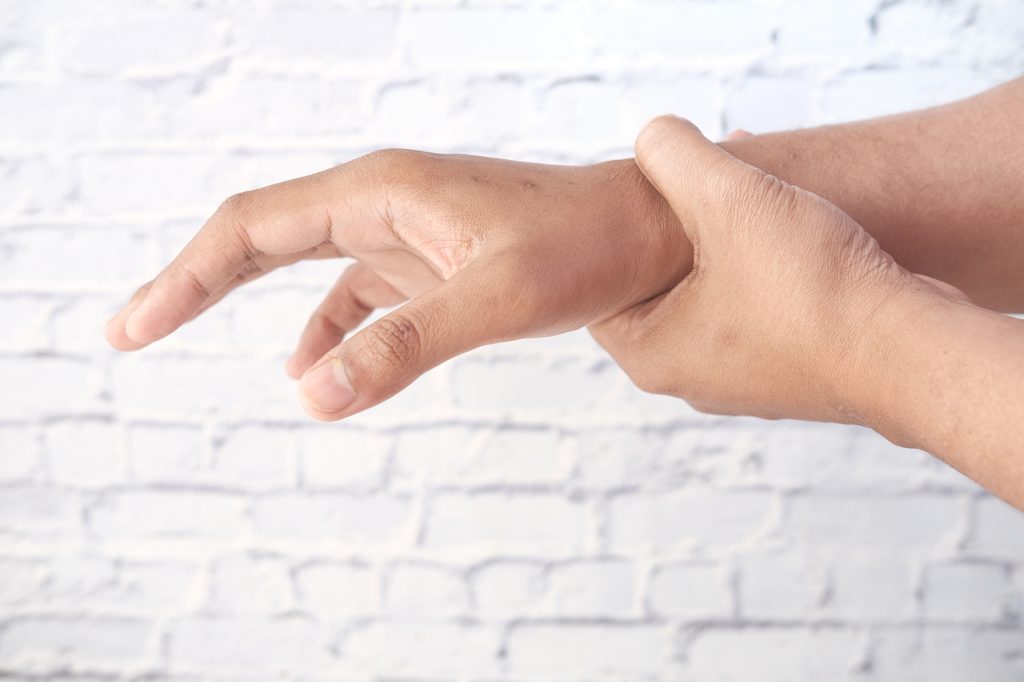Wrist ganglion
Causes, symptoms and treatment
Have you noticed a noticeable bulge on your wrist that just won’t go away? Perhaps it is elastic, sometimes painful, or visually disturbing? In many cases, such changes are caused by a so-called wrist ganglion, also known as a ganglion cyst. Although this cyst is benign, it can still cause discomfort and restrict mobility. Find out here what causes a ganglion cyst, what the typical symptoms are, and what treatment options are available.
Dupuytren’s contracture is a condition that often begins unnoticed—and then doesn’t let go. But what exactly is behind it? What are the first warning signs? And what treatment options are available before everyday life becomes a burden?

What is a wrist ganglion?
A wrist ganglion, commonly known as a ganglion cyst, is a benign cyst located on the flexor or extensor side of the wrist. This protrusion is filled with a gel-like fluid and can be elastic or hard, causing dull pain. In some cases, however, a ganglion cyst causes no symptoms and can shrink on its own or even disappear completely.
Causes of a wrist ganglion
Doctors suspect that ganglions can be caused by instability, excessive strain, or rheumatic diseases. Problems can be related to repetitive strain or minor injuries to the wrist. In most cases, ganglions develop on the back of the hand, but in some cases they can also appear on the palm side of the wrist and, rarely, on the fingers or the side of the joint.
Complaints of a ganglion on the wrist
Complaints of a ganglion on the wrist
The symptoms of a ganglion are:The symptoms of a ganglion are:
The symptoms of a ganglion are:
- Protrusion: A noticeable protrusion and swelling on the back of the hand, which is usually elastic and can change in size.
- Pain: Some ganglia are painless, but others can cause dull or burning pain.
- Restricted movement and sensory disturbances: Particularly large ganglions can make it impossible to move the hand without restrictions.
- Aesthetically disturbing: Many affected individuals find a ganglion to be unsightly.

Diagnostics
In most cases, a ganglion on the wrist can be identified by the bulge and the symptoms described by the patient. If the suspicion is confirmed, imaging is performed using sonography, i.e., ultrasound. Magnetic resonance imaging (MRI) is only necessary in rare cases. An X-ray can then provide certainty as to whether there is another problem in the bone.
Treatment - therapy and operation
Whether conservative treatment is sufficient or surgery is necessary depends on the patient’s symptoms.
Therapy
If the ganglion does not regress on its own or causes symptoms in everyday life, it must be surgically removed. This involves not only removing the ganglion through a small incision in the skin, but also the ganglion stalk, which supplies the cyst with fluid. This prevents a new cyst from forming and another ganglion from developing.
If the ganglion is particularly small and cannot be felt, arthroscopy may also be performed. In this minimally invasive procedure, the ganglion is removed from the joint, causing it to dry out as joint fluid can no longer flow to it.
Follow-up treatment of the hand after surgery
- Immediately after the operation, the hand is immobilized with a compression bandage. Once the bandage has been removed, occupational therapy begins in order to prevent the joint from stiffening.
- Two weeks after the procedure, the stitches are removed and a scar ointment (e.g., calendula, Bepanthen) is prescribed to support the healing of the scar.
- After 4-6 weeks, you will be able to use and put weight on your hand again as normal and without restrictions.
Your specialist for hand surgery in Vienna - Dr. Sebastian Farr
Dr. Sebastian Farr is a specialist in orthopedics and hand surgery with many years of experience as a senior physician at the Orthopedic Hospital Speising. In his practice, he offers comprehensive consultation and individualized treatment options for diseases and injuries of the hand and upper extremities. From diagnosis to therapy to aftercare, Dr. Farr personally accompanies his patients and attaches great importance to precise diagnostics and targeted therapy.
His goal is to restore hand function as much as possible and relieve pain in the long term.
For further information or to make an appointment at the practice of Dr. Sebastian Farr in Vienna, please contact us by phone, online, or by email.

FAQ – Frequently asked questions about wrist ganglion cysts
Is a ganglion dangerous?
No, a wrist ganglion is benign and not malignant. However, it can cause pain, restrict mobility, or be considered unsightly for aesthetic reasons.
Can a ganglion disappear on its own?
Yes, in many cases, a ganglion will regress spontaneously or become smaller without the need for treatment.
Does a ganglion always require surgery?
No. Surgery is only necessary if the ganglion causes severe pain, restricted movement, or nerve compression. Otherwise, observation or conservative treatment is often sufficient.
How long does it take to heal after an operation?
After surgical removal, complete healing usually takes 4–6 weeks. However, patients can carefully move their hand again after a short time.
Can a ganglion reappear after removal?
Despite complete removal, a ganglion can rarely reappear. However, removing the ganglion stalk as well significantly reduces this risk.
Are there ways to prevent a ganglion?
There is no known specific prevention method. However, working carefully, avoiding prolonged strain, and treating wrist injuries promptly can reduce the risk.